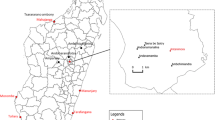Abstract
Laboratory-reared Xenopsylla brasiliensis and X. cheopis obtained from several parts of Tanzania were tested with 0.5% malathion, using the standard WHO test kit.
Two strains of Xenopsylla brasiliensis (Mbulu and Amani) were more susceptible as 100% mortality was obtained after 12 hr exposure. With the remaining populations, 100% mortality was obtained after 24 hr exposure. LT50 of X. brasiliensis were 3.1, 3.3 and 4.5 hr for Mbulu, Tawalani and Amani strains respectively. Similarly, LT50 of X. cheopis were 8.1, 7 and 5.4 hr for Chunya, Amani and Tawalani strains respectively.
It was generally concluded that malathion was a suitable insecticide for use in flea and consequently plague control in Tanzania as X. brasiliensis and X. cheopis are the commonest flea vectors of the disease in the country. Moreover, the insecticide is locally available and it has limited toxicity on non-target organisms and little persistence in the environment.
ésumé
Des pucés appartenant aux especes Xenophylla brasiliensis et X. cheopis élevées en laboratoire á partir de prélevements opérés dans diffentes régions de Tanzanie ont été soumises á des tests de sensibilité au malathion á une concentration de 0.5% á laide dún test standard repondant aux normes de l’OMS.
Deux souches de X. brasiliensis (Mbulu et Amani) se sont révelées les plus sensibles, montrant une mortalité de 100% apres 12 hr d’exposition á lágent chimigne. Pour les antres souches les 100% de mortalité ont été atteintes apres 24 hr d’exposition.
Le malathioń sést done avec etre un insecticide efficase contre les puces et done bien adapte á la lutte contre la peste en Tanzanie, X. brasiliensis et X. cheopis etánt les plus importants vecteurs de catte maladie dans ce pays. Le malathion a en outre l’avantage d’entre disponible sur le marché local, d’avoir une faible toxicité envers les animaux a sang chand et d’avoir une remanence limite.
Similar content being viewed by others
References
Brown A. W. A. and Pal R. (1971) Insecticide Resistance in Arthropods, 2nd edn, pp. 248–251. World Health Organization, Geneva.
Christensen J. T. (1984) Pre- and post-treatment flea populations at the pilot control project villages, Morogoro district, Tanzania. Quarterly report of the National Rodent Control Project, Morogoro, April—June 1984, p. 9.
Kilonzo B. S. (1976) A survey of rodents and their flea ectoparasites in northeast Tanzania. E. Afr. J. med. Res. 3, 117.
Kilonzo B. S. and Mhina J. I. K. (1982) The first outbreak of human plague in Lushoto district, northeast Tanzania. Trans. R. Soc. trop. Med. Hyg. 76, 172.
Kilonzo B. S. and Mtoi R. S. (1983) Entomological, bacteriological and serological observations after the 1977 plague outbreak in Mbulu District, Tanzania. E. Afr. med. J. 60, 91.
Kilonzo B. S. (1984) Studies on the present status of endemicity, mammalian reservoirs and flea vectors of plague in Tanzania. Ph.D. thesis, University of Dar es Salaam.
Kumar R. (1980) Trends in pest management: use of pesticides in the control of crop pests. A teaching paper presented at the ICIPE/UNEP International Group training course in components essential for ecologically sound pest and vector management systems. Nairobi, June 1980.
Msangi A. S. (1968) Observations on the endemicity of plague in Tanzania. Ph.D. thesis, University of London.
O’Brien R. D. (1967) Insecticides. Action and Metabolism, pp. 32–79, 269. Academic Press, New York.
Smith A. (1959) The susceptibility to Dieldrin of Pulex irritans and Pediculus humanus corporis in the Pare area of north-east Tanganyika. Bull. Wld Hlth Org. 21, 240.
WHO (1975) Instructions for determining the susceptibility or resistance of fleas to insecticides. WHO/VBC/75, 588 Rev. 1.
Author information
Authors and Affiliations
Rights and permissions
About this article
Cite this article
Kilonzo, B.S. The Baseline Susceptibility Levels of Laboratory-Reared Tanzania Fleas to Malathion. Int J Trop Insect Sci 7, 525–527 (1986). https://doi.org/10.1017/S1742758400009772
Received:
Revised:
Published:
Issue Date:
DOI: https://doi.org/10.1017/S1742758400009772




